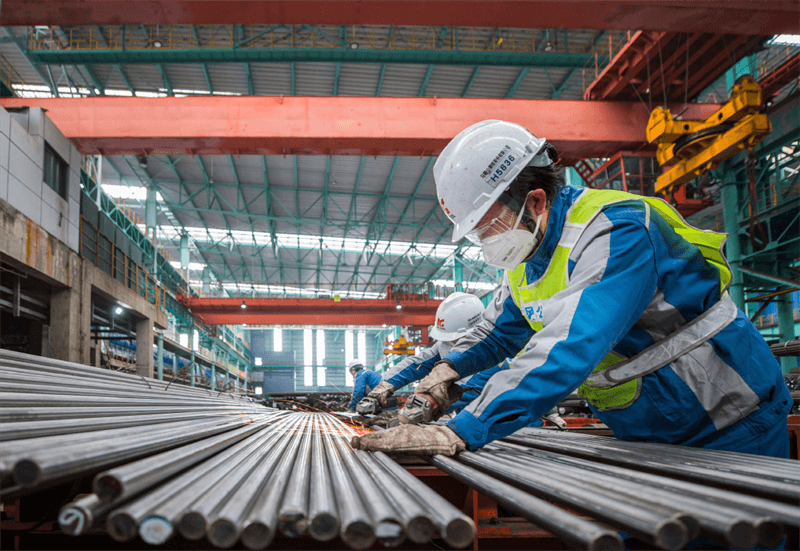
Employees check steel tubes at a production facility in Maanshan, Anhui province, in March. [Photo by LUO JISHENG/FOR CHINA DAILY]
Adding more strain to global steel supplies and price inflation of raw materials, the Russia-Ukraine conflict has increased China’s steel production costs, yet experts said as domestic steel market expectations level off amid Chinese authorities’ efforts to ensure stable economic growth, the domestic steel industry is well-poised for healthy development despite such external factors.
“The decline in steel output from Russia and Ukraine, two important global steel suppliers, has resulted in a significant markup in world steel prices, but the impact on the China market is limited,” said Wang Guoqing, director of the Lange Steel Information Center.
Russia and Ukraine together account for 8.1 percent of global iron ore production, while their overall output contribution of pig iron and crude steel was 5.4 percent and 4.9 percent, respectively, according to a recent report by Huatai Futures.
In 2021, pig iron output of Russia and Ukraine totaled 51.91 million metric tons and 20.42 million tons, respectively, and for crude steel production 71.62 million tons and 20.85 million tons, respectively, the report said.
Due to the geopolitical woes, steel prices in overseas markets have surged amid the panic of impacted supplies of not only finished steel products but also raw materials and energy, as Russia and Ukraine are among the world’s major suppliers of energy and metal commodities, Wang said.
The increased prices, including that of iron ore and palladium, have led to higher domestic steel production costs, which triggered an upward price trend in the domestic steel market in China, she added.
As of last week, steel plate, rebar and hot-rolled coil prices had soared by 69.6 percent, 52.7 percent, and 43.3 percent, respectively, in the European Union since the outbreak of the conflict. Steel prices in the United States, Turkey and India have also risen by more than 10 percent. Spot prices of hot-rolled coil and rebar increased relatively marginally in Shanghai-5.9 percent and 5 percent, respectively, the Huatai report said.
Xu Xiangchun, information director and analyst with iron and steel consultancy Mysteel, also said surging prices of global steel, energy and commodities have had a spillover effect on domestic steel prices.
In China, however, with authorities’ stabilizing efforts taking effect, the domestic steel market will get back on track, analysts said.
“Domestic infrastructure investment has shown an obvious upward momentum, thanks to the issuance of many local government-specific bonds and the implementation of a slew of major projects, while the policy measures facilitating manufacturing growth will also improve market expectations for the manufacturing sector.
“That will jointly shore up overall steel demand in China, despite the probable decline in steel demand from the real estate sector,” Xu said.
There has been a certain dip in steel demand recently due to the resurgence of the COVID-19 pandemic in some places, but with the contagion coming back under control, there is likely to be a spike in steel demand in the domestic market, he added.
Xu also forecast China’s total steel demand will drop 2 to 3 percent year-on-year in 2022, which is expected to be slower than the 2021 figure, or 6 percent.
Wang said the domestic steel market has received a relatively limited impact from the Russia-Ukraine conflict, mainly because China has a strong steel production capability, and its direct steel trade with Russia and Ukraine takes up a small part of the nation’s overall steel trade activity.
Due to higher steel prices in global markets compared with the domestic market, China’s steel export volume may go up in the short term, easing the pressure of excessive domestic supplies, she said, predicting that the increase will be limited-around 5 million tons on average per month.
Expectations for the domestic steel market are also optimistic, thanks to the nation’s emphasis on stable economic growth in 2022, Wang added.
Post time: Apr-14-2022